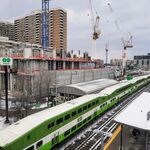DISA – Digital Voice Output
Passenger information system for blind and visually impaired people in public transport
In most of today’s large cities optical passenger information systems are now part of the ‘standard’ equipment of public transport. On displays incoming trams or busses are indicated with their approximate time of arrival. This information provides convenience and safety to the people using public transport. However, blind and visually impaired people (e.g. older people with age-related amblyopia) who usually depend on public transport do not have access to this information.
In order to make passenger information accessible to this group of people a system called DISA (Digitale Sprachausgabe = digital voice output) was developed in Linz (Austria) in cooperation with the Austrian association for blind and visually impaired people and the Linz transportation company (Linz AG Linien).
Via a digital voice output the information of the passenger information system is transformed into speech and is now available for people with a visual impairement. In order to locate DISA, which can be easily integrated into existing systems, the user has the choice to request a blip from DISA with a small hand-held transmitter. If a person is located further away from the tram/bus stop the blip is an excellent help to find the digital voice output. In case the person already stands next to the device the voice output can be either activated by using the hand-held transmitter or the push-button of the device.
After a long period of preliminary planning DISA was tested at 4 tram stops in Linz in spring 2004 in the context of a pilot project. Following a successful run further installations were planned. In the meantime 44 units have been installed in Linz and 60 additional units are planned until 2009. In medium term DISA is planned to be installed area-wide.
What is so interesting about DISA compared to other systems?
DISA is a system bounded at tram/bus stops and therefore features a great number of advantages for its user as well as for public transport operators. Some of these advantages are:
- Early information about arriving trams/busses
- Great user-friendliness because of its easy handling and therefore suitable for all ages
- Compared to systems bounded to vehicles a continuous installation is possible
- No changes within the operational control system or vehicle technology
- Simple and fast integration in existing systems
- Manageable costs for public transport operators
- Proven and tested system




